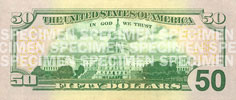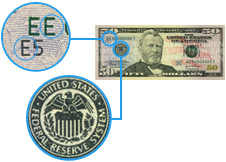Currency index
Advertisements
United States fifty dollar bill

Description:
Size: 155.956 x 66.294 mm
Paper type: 75% cotton, 25% linen


The United States fifty dollar bill is
a denomination of United States currency. Ulysses S. Grant is currently featured
on the obverse, while the US Capitol is featured on the reverse. All current-issue $50 bills are Federal Reserve Notes.
The Bureau of Engraving and Printing says the average life of a $50 bill in
circulation is 55 months before it is replaced due to wear. Approximately 3.8% of
all notes printed in 2017 were 50 dollar bills. They are delivered by Federal Reserve Banks in brown straps.
The redesigned US fifty dollar ($50) bill incorporates two easy to use security features,
subtle shades of blue and red, and historical symbols of freedom.
Security Features:
Security features can help you to tell if a 50 dollar bill is fake or real.
Color-Shifting Ink

Tilt the bill to see if the numeral 50 in the lower right corner on the front of the bill
changes colors from copper to green. The color shift is more dramatic in the redesigned currency making it even easier
for people to check their money.
Watermarks

Hold the bill to light and look for the watermark, or faint image, similar to the large portrait.
The watermark is part of the paper itself and can be seen from both sides of the bill.
Security Thread

Hold the bill to light and look for the security thread that is embedded in the paper and runs vertically up one
side of the bill. If you look closely, the words USA 50 and a small flag are visible along the thread from both
sides of the bill. The security thread glows yellow when illuminated by ultraviolet light.
The redesigned 50 dollar bill remains the same size and uses the same, but enhanced portraits and historical images as the older-design bills, and most importantly, continues to be recognized around the world as quintessentially American.
Symbols of Freedom

Symbols of freedom have been added to the design on
the front of the fifty US dollar bill to represent images of the American flag. The
traditional stars and stripes of the United States flag are printed in blue and
red behind the portrait of President Grant. A field of blue stars is located to
the left of the portrait, while three red stripes are located to the right of
the portrait. A small metallic silver-blue star is located on the lower right
side of the portrait. The symbols of freedom differ for each denomination
Color
The most noticeable difference in the redesigned $50 note is the addition of subtle background colors of blue and red to both sides of the bill. The background colors add complexity to the bills and differ with each denomination to help distinguish them. Because color can be duplicated by potential counterfeiters, it should not be used to verify the authenticity of the bill.
Updated Portrait and Vignette

The oval borders and fine lines surrounding the portrait of President Grant on the front and
the vignette of the United States Capitol Building on the back have been removed.
The portrait has been moved up and shoulders have been extended into the
border. Additional engraving details have been added to the vignette background.
Low-Vision Feature

The numeral 50 in the lower
right corner on the back of the bill is enlarged to help those with visual
impairments distinguish the denomination.
Microprinting

Because they are so small, microprinted words are hard to replicate. The redesigned 50 dollar bill features
microprinting on the front of the note in three areas: the words FIFTY, USA, and the numeral 50 can be found in two of
the blue stars to the left of the portrait; the word FIFTY can be found
repeated within both side borders of the bill; and the words THE UNITED STATES OF AMERICA appear
on President Ulysses S. Grant's collar, under hisbeard
Federal Reserve Indicators

A universal seal to the left of the portrait represents the entire Federal Reserve
System. A letter and number beneath the left serial number identifies the issuing Federal Reserve Bank.
There are 12 regional Federal Reserve Banks and 24 branches located in major cities throughout the United States.
Serial Numbers

The unique combination of eleven numbers and letters appears twice on the front of the note. On the redesigned US fifty
dollar bill, the left serial number has shifted slightly to the right, compared with previous designs.
Because they are unique identifiers, serial numbers help law enforcement
identify fake notes, and they also help the Bureau of Engraving and
Printing track quality standards for the notes they produce.
Check this video of fake 50 dollar bill
In this video you can see a fake U.S 50 Dollar bill compared to a real one.
Sources:
uscurrency.gov
wikipedia.org











Follow currencyguide.eu